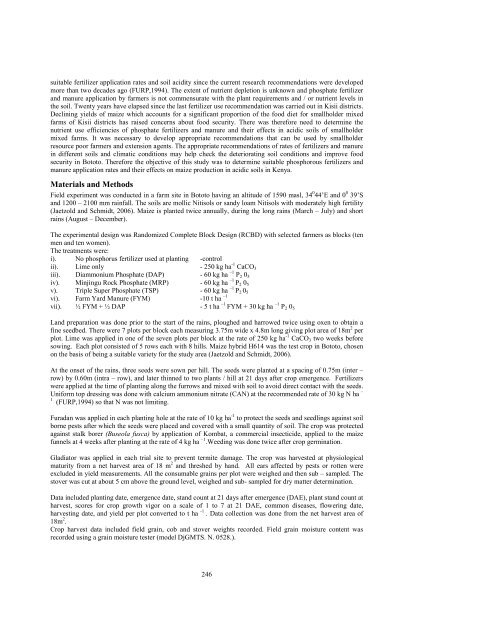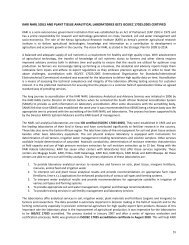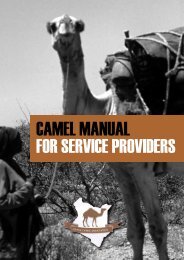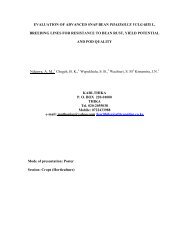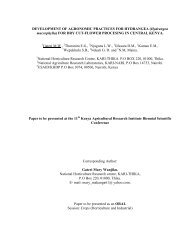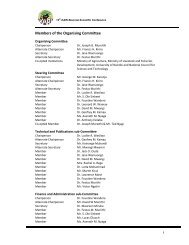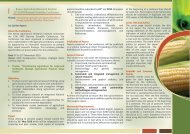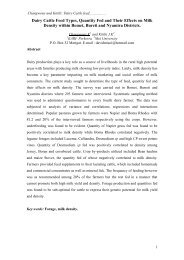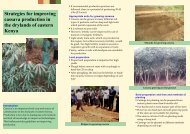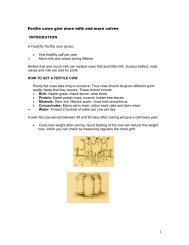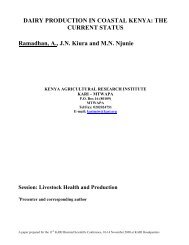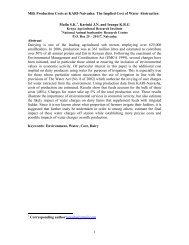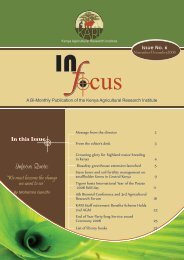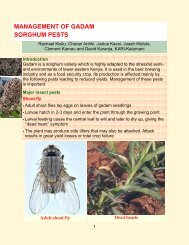evaluation of organic and inorganic amendments on nutrient uptake ...
evaluation of organic and inorganic amendments on nutrient uptake ...
evaluation of organic and inorganic amendments on nutrient uptake ...
Create successful ePaper yourself
Turn your PDF publications into a flip-book with our unique Google optimized e-Paper software.
suitable fertilizer applicati<strong>on</strong> rates <str<strong>on</strong>g>and</str<strong>on</strong>g> soil acidity since the current research recommendati<strong>on</strong>s were developed<br />
more than two decades ago (FURP,1994). The extent <str<strong>on</strong>g>of</str<strong>on</strong>g> <strong>nutrient</strong> depleti<strong>on</strong> is unknown <str<strong>on</strong>g>and</str<strong>on</strong>g> phosphate fertilizer<br />
<str<strong>on</strong>g>and</str<strong>on</strong>g> manure applicati<strong>on</strong> by farmers is not commensurate with the plant requirements <str<strong>on</strong>g>and</str<strong>on</strong>g> / or <strong>nutrient</strong> levels in<br />
the soil. Twenty years have elapsed since the last fertilizer use recommendati<strong>on</strong> was carried out in Kisii districts.<br />
Declining yields <str<strong>on</strong>g>of</str<strong>on</strong>g> maize which accounts for a significant proporti<strong>on</strong> <str<strong>on</strong>g>of</str<strong>on</strong>g> the food diet for smallholder mixed<br />
farms <str<strong>on</strong>g>of</str<strong>on</strong>g> Kisii districts has raised c<strong>on</strong>cerns about food security. There was therefore need to determine the<br />
<strong>nutrient</strong> use efficiencies <str<strong>on</strong>g>of</str<strong>on</strong>g> phosphate fertilizers <str<strong>on</strong>g>and</str<strong>on</strong>g> manure <str<strong>on</strong>g>and</str<strong>on</strong>g> their effects in acidic soils <str<strong>on</strong>g>of</str<strong>on</strong>g> smallholder<br />
mixed farms. It was necessary to develop appropriate recommendati<strong>on</strong>s that can be used by smallholder<br />
resource poor farmers <str<strong>on</strong>g>and</str<strong>on</strong>g> extensi<strong>on</strong> agents. The appropriate recommendati<strong>on</strong>s <str<strong>on</strong>g>of</str<strong>on</strong>g> rates <str<strong>on</strong>g>of</str<strong>on</strong>g> fertilizers <str<strong>on</strong>g>and</str<strong>on</strong>g> manure<br />
in different soils <str<strong>on</strong>g>and</str<strong>on</strong>g> climatic c<strong>on</strong>diti<strong>on</strong>s may help check the deteriorating soil c<strong>on</strong>diti<strong>on</strong>s <str<strong>on</strong>g>and</str<strong>on</strong>g> improve food<br />
security in Bototo. Therefore the objective <str<strong>on</strong>g>of</str<strong>on</strong>g> this study was to determine suitable phosphorous fertilizers <str<strong>on</strong>g>and</str<strong>on</strong>g><br />
manure applicati<strong>on</strong> rates <str<strong>on</strong>g>and</str<strong>on</strong>g> their effects <strong>on</strong> maize producti<strong>on</strong> in acidic soils in Kenya.<br />
Materials <str<strong>on</strong>g>and</str<strong>on</strong>g> Methods<br />
Field experiment was c<strong>on</strong>ducted in a farm site in Bototo having an altitude <str<strong>on</strong>g>of</str<strong>on</strong>g> 1590 masl, 34 0 44’E <str<strong>on</strong>g>and</str<strong>on</strong>g> 0 0 39’S<br />
<str<strong>on</strong>g>and</str<strong>on</strong>g> 1200 – 2100 mm rainfall. The soils are mollic Nitisols or s<str<strong>on</strong>g>and</str<strong>on</strong>g>y loam Nitisols with moderately high fertility<br />
(Jaetzold <str<strong>on</strong>g>and</str<strong>on</strong>g> Schmidt, 2006). Maize is planted twice annually, during the l<strong>on</strong>g rains (March – July) <str<strong>on</strong>g>and</str<strong>on</strong>g> short<br />
rains (August – December).<br />
The experimental design was R<str<strong>on</strong>g>and</str<strong>on</strong>g>omized Complete Block Design (RCBD) with selected farmers as blocks (ten<br />
men <str<strong>on</strong>g>and</str<strong>on</strong>g> ten women).<br />
The treatments were:<br />
i). No phosphorus fertilizer used at planting -c<strong>on</strong>trol<br />
ii). Lime <strong>on</strong>ly - 250 kg ha -1 CaCO 3<br />
iii). Diamm<strong>on</strong>ium Phosphate (DAP) - 60 kg ha –1 P 2 0 5<br />
iv). Minjingu Rock Phosphate (MRP) - 60 kg ha –1 P 2 0 5<br />
v). Triple Super Phosphate (TSP) - 60 kg ha –1 P 2 0 5<br />
vi). Farm Yard Manure (FYM) -10 t ha –1<br />
vii). ½ FYM + ½ DAP - 5 t ha –1 FYM + 30 kg ha –1 P 2 0 5<br />
L<str<strong>on</strong>g>and</str<strong>on</strong>g> preparati<strong>on</strong> was d<strong>on</strong>e prior to the start <str<strong>on</strong>g>of</str<strong>on</strong>g> the rains, ploughed <str<strong>on</strong>g>and</str<strong>on</strong>g> harrowed twice using oxen to obtain a<br />
fine seedbed. There were 7 plots per block each measuring 3.75m wide x 4.8m l<strong>on</strong>g giving plot area <str<strong>on</strong>g>of</str<strong>on</strong>g> 18m 2 per<br />
plot. Lime was applied in <strong>on</strong>e <str<strong>on</strong>g>of</str<strong>on</strong>g> the seven plots per block at the rate <str<strong>on</strong>g>of</str<strong>on</strong>g> 250 kg ha -1 CaCO 3 two weeks before<br />
sowing. Each plot c<strong>on</strong>sisted <str<strong>on</strong>g>of</str<strong>on</strong>g> 5 rows each with 8 hills. Maize hybrid H614 was the test crop in Bototo, chosen<br />
<strong>on</strong> the basis <str<strong>on</strong>g>of</str<strong>on</strong>g> being a suitable variety for the study area (Jaetzold <str<strong>on</strong>g>and</str<strong>on</strong>g> Schmidt, 2006).<br />
At the <strong>on</strong>set <str<strong>on</strong>g>of</str<strong>on</strong>g> the rains, three seeds were sown per hill. The seeds were planted at a spacing <str<strong>on</strong>g>of</str<strong>on</strong>g> 0.75m (inter –<br />
row) by 0.60m (intra – row), <str<strong>on</strong>g>and</str<strong>on</strong>g> later thinned to two plants / hill at 21 days after crop emergence. Fertilizers<br />
were applied at the time <str<strong>on</strong>g>of</str<strong>on</strong>g> planting al<strong>on</strong>g the furrows <str<strong>on</strong>g>and</str<strong>on</strong>g> mixed with soil to avoid direct c<strong>on</strong>tact with the seeds.<br />
Uniform top dressing was d<strong>on</strong>e with calcium amm<strong>on</strong>ium nitrate (CAN) at the recommended rate <str<strong>on</strong>g>of</str<strong>on</strong>g> 30 kg N ha –<br />
1 (FURP,1994) so that N was not limiting.<br />
Furadan was applied in each planting hole at the rate <str<strong>on</strong>g>of</str<strong>on</strong>g> 10 kg ha -1 to protect the seeds <str<strong>on</strong>g>and</str<strong>on</strong>g> seedlings against soil<br />
borne pests after which the seeds were placed <str<strong>on</strong>g>and</str<strong>on</strong>g> covered with a small quantity <str<strong>on</strong>g>of</str<strong>on</strong>g> soil. The crop was protected<br />
against stalk borer (Buseola fusca) by applicati<strong>on</strong> <str<strong>on</strong>g>of</str<strong>on</strong>g> Kombat, a commercial insecticide, applied to the maize<br />
funnels at 4 weeks after planting at the rate <str<strong>on</strong>g>of</str<strong>on</strong>g> 4 kg ha –1 .Weeding was d<strong>on</strong>e twice after crop germinati<strong>on</strong>.<br />
Gladiator was applied in each trial site to prevent termite damage. The crop was harvested at physiological<br />
maturity from a net harvest area <str<strong>on</strong>g>of</str<strong>on</strong>g> 18 m 2 <str<strong>on</strong>g>and</str<strong>on</strong>g> threshed by h<str<strong>on</strong>g>and</str<strong>on</strong>g>. All ears affected by pests or rotten were<br />
excluded in yield measurements. All the c<strong>on</strong>sumable grains per plot were weighed <str<strong>on</strong>g>and</str<strong>on</strong>g> then sub – sampled. The<br />
stover was cut at about 5 cm above the ground level, weighed <str<strong>on</strong>g>and</str<strong>on</strong>g> sub- sampled for dry matter determinati<strong>on</strong>.<br />
Data included planting date, emergence date, st<str<strong>on</strong>g>and</str<strong>on</strong>g> count at 21 days after emergence (DAE), plant st<str<strong>on</strong>g>and</str<strong>on</strong>g> count at<br />
harvest, scores for crop growth vigor <strong>on</strong> a scale <str<strong>on</strong>g>of</str<strong>on</strong>g> 1 to 7 at 21 DAE, comm<strong>on</strong> diseases, flowering date,<br />
harvesting date, <str<strong>on</strong>g>and</str<strong>on</strong>g> yield per plot c<strong>on</strong>verted to t ha -1 . Data collecti<strong>on</strong> was d<strong>on</strong>e from the net harvest area <str<strong>on</strong>g>of</str<strong>on</strong>g><br />
18m 2 .<br />
Crop harvest data included field grain, cob <str<strong>on</strong>g>and</str<strong>on</strong>g> stover weights recorded. Field grain moisture c<strong>on</strong>tent was<br />
recorded using a grain moisture tester (model DjGMTS. N. 0528.).<br />
246


